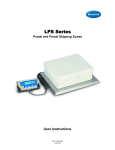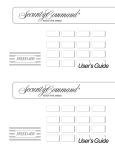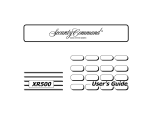Download Bosch D1256 User`s guide
Transcript
Fire System User’s Guide Table of Contents Introduction Command Center Function Keys Viewing System Events Warning Displays and Tones Fire Alarms Silencing Fire Troubles Detector Reset Key Annunciator Reset Key The Idle Display How the System Reports Alarms System Functions View Memory Fire Test View Log Remote Program System Trouble Displays Log Event Definitions System Glossary Maintenance and Service 3 4 5 5 6 7 8 9 10 11 12 13 14 16 17 21 23 26 27 1 2 Introduction Using the Command Center Your system’s command center is an advanced digital device that offers a variety of features. Its highly visible, back-lit keypad and built-in sounder alert you to a number of system events. Your system provides access to functions through the Menu. Access the Menu by pressing the [ESC] key. Pressing the [PREV] or [NEXT] key allows you to scroll up or down through the list of functions programmed by your security company. Pressing the [ENT] key initiates the function displayed. To exit the Menu, press the [ESC] key. About This User’s Guide This User’s Guide covers basic system features. It is designed to be an everyday type of reference for system users. The functions described in this guide are programmed by your security company. Some of them may not be included in your system. Throughout this guide the # symbol refers to a variable numerical quantity, such as the number of points to test. Messages that appear in the command center display appear in this guide LIKE THIS. Keys that you must press appear [LIKE THIS]. What is a Point? A “point” is a detection device, or group of devices connected to your system. Points display individually at the command center with custom text. The text can describe a single smoke detector, or an area such as FIRST FLOOR or LOBBY. 3 Command Center Function Keys ENT (Enter) Your command center has four function keys. These keys are used to control your system. The function of the [ENT] key is to select the menu item displayed. Command Center Quiets for Keystrokes ESC (Escape) The [ESC] key has two functions. First, the [ESC] key is used to enter the Menu. Pressing this key takes you to the first item in the menu. Pressing [ESC], [PREV], [NEXT], or [ENT] lights the keys and quiets any warning tones. If you don’t press another key within 20 seconds, the keypad lights go out and the warning tones resume. Second, pressing [ESC] takes you back to the idle display. PREV (Previous) When viewing a list, pressing the [PREV] key takes you back to the previously shown item. NEXT Press the [NEXT] key to view the next item in a menu or list. 4 Viewing System Events Warning Displays and Tones Your system automatically displays fire alarm events or fire trouble events as they occur. Fire trouble events include such things as a broken wire or a closed sprinkler system valve. Your command center emits one of several distinct tones and displays custom text to alert you to system events. Additional bells or horns may also be connected to your system. Audible and visual devices such as horns and strobes alert you to emergencies. Priority of Events If more than one event occurs, your system sorts them into one of three groups. The groups (highest priority first) are: Fire Alarms, Fire Troubles, and Non-Fire Troubles. The group with the highest priority scrolls first in the command center’s display. Descriptions of the tones and displays for each group and instructions for silencing the tones are included in the descriptions that follow. 5 Fire Alarms Alarm Silence Key Fire alarms are the highest priority events. When a fire point activates, your command center emits a pulsating high-pitched fire tone. Evacuate all occupants and investigate for smoke or fire. The tone sounds for the time set by your servicing company. Press the [ALARM SILENCE] key to silence a fire alarm. After pressing [ALARM SILENCE], the system briefly displays * FIRE SYSTEM * followed by ALARM SILENCED and then the number of fire points in alarm (A1 ## FIRE ALARM) in the area and then the custom text of all the points in alarm in the order of occurrence. Your system may be programmed so that you cannot silence some fire alarms until the fire event is cleared. The example below illustrates the displays one would see with two points in alarm. See the description of the Detector Reset key and the Annunciator Reset key for more information. The command center display shows only the point text of the first point that went into fire alarm. Pressing the [NEXT] manually displays additional points (if any) that went into alarm. Events scroll from the oldest to the newest. * FIRE SYSTEM * ALARM SILENCED A1 2 FIRE ALARM LOBBY SMOKE 1ST FLOOR 6 Silencing Fire Troubles Special System Trouble Display After an alarm is silenced, the device that caused the alarm is usually still faulted or activated. In the case of a smoke detector, it must be reset by pressing the [DETECTOR RESET] button (see page 8). An off-normal device creates a fire trouble condition. Examples of trouble conditions include such things as a closed valve or broken wire. When a fire trouble occurs, your command center emits three warble tones, then a pause (repeatedly). SERVC AC FAIL and SERVC BATT LOW are examples of special system trouble displays. These displays appear on all keypads in the system. These trouble displays begin with SERVC. See System Trouble Displays on page 21 for a description of each system trouble display. Pressing the [TROUBLE SILENCE] key will silence a system trouble tone, but the SERVC display will not clear until the faulted condition is corrected. The system displays the number of fire points with troubles (A1 ## FIRE TRBLE) in an area and then repeatedly displays the custom text for all the points in trouble in the order of occurrence. Trouble Silence Key Pressing the [TROUBLE SILENCE] key silences a fire trouble. If the fault condition is still present, the display will repeatedly scroll from * FIRE SYSTEM * to FIRE TROUBLE. Manually press the [NEXT] key repeatedly to display all of the devices that are still off normal. When all devices return to normal, the FIRE TROUBLE display automatically clears. If you wish to review cleared troubles, this can be done by pressing the [ESC] key to enter the Menu and then pressing [NEXT] until VIEW MEMORY ? is displayed. See the VIEW MEMORY ? function on page 13 for more information. 7 Detector Reset Key Description Detection devices, such as smoke detectors, must be reset after being activated. Pressing the [DETECTOR RESET] key momentarily removes power from these sensors to reset them. Detector Reset Key If the fault condition is still present, the display repeatedly scrolls from * FIRE SYSTEM * to FIRE TROUBLE. Manually press the [NEXT] key repeatedly to display all of the devices that are still off-normal. When all devices return to normal the FIRE TROUBLE display automatically clears. Check to be certain that there is no smoke, fire, or other danger present. If you can’t reset the detector or sensor contact your service company. After pressing this key, the display shows SENSORS RESETING for approximately 3 seconds and then goes blank before returning to the repeated display of * FIRE SYSTEM * followed by ALARM SILENCED. This function clears alarm point information from the display. The ALARM SILENCED message continues to display as a reminder that the VIEW MEMORY ? function can still be used to view cleared point information. Pressing the [ANNUNCIATOR RESET] key clears both the View Memory buffer and the ALARM SILENCED display. For more information see the description of the VIEW MEMORY ? function (page 13). 8 Annunciator Reset Key Description After the [ALARM SILENCE], [TROUBLE SILENCE] and/or [DETECTOR RESET] keys are pressed, retrieve the cleared keypad display information with the View Memory ? menu function. Pressing the [ANNUNCIATOR RESET] key clears the ALARM SILENCED message from the display and clears the VIEW MEMORY ? buffer and returns the display to idle text. Thereafter the VIEW MEMORY ? function displays NO EVENTS until another trouble or alarm occurs. Using [ANNUNCIATOR RESET] has no effect on the VIEW LOG ? function. See the VIEW MEMORY ? and VIEW LOG ? functions for more information. 9 The Idle Display “At an idle state” means that the system is not currently performing a function entered by a user. • PRESS ALARM SIL Indicates that the [ALARM SILENCE] key needs to be pressed. • * FIRE SYSTEM * This is the normal idle display that indicates the system is normal and ready to function. • CHECK FIRE SYS This is one of a number of displays that indicate the system requires service. This guide uses the default idle state displays for examples of these idle states. Your security company may have programmed custom text for the idle displays in your system. 10 Keystroke Checking Tones How the System Reports Alarms Valid Entry Your system may be programmed to automatically send reports to your monitoring facility. This communication temporarily disconnects your telephones. Once the report is completed, your system returns the telephones to normal operation (check with your servicing company). If you press an appropriate key for the function or entry you desire, the command center sounds a muted beep tone, indicating it accepted your keystroke. Invalid Entry A flat buzz tone sounds when you press a key that doesn’t have a function to execute or when the command center has no information to display. Your system makes repeated attempts to send reports to your monitoring facility. In the event your system fails to communicate, the command center buzzes and displays SERVC COMM FAIL. Notify your servicing company of the communications failure. Note: If your telephone service is interrupted, your system cannot send reports unless it has an alternate means of transmitting them. 11 System Functions Below is a summary of the features covered in this guide. Some of these functions may not be available in your menu. Access the menu by pressing the [ESC] key. The first menu item, ALARM SILENCE ?, is displayed. This function can be selected by pressing the [ENT] key. Doing this has the same effect as pressing the [ALARM SILENCE] key. Pressing the [NEXT] key when ALARM SILENCE ? is displayed brings up the second menu item, which is TROUBLE SILENCE ?. Pressing [NEXT] again displays the third item in the menu, DETECTOR RESET ?. Pressing [NEXT] once more displays the fourth menu item, ANNUNCATOR RESET ?. These menu items perform the same functions as the first four keys on the command center. Continue pressing the [NEXT] key to access special menu items that might be programmed into your system by your servicing company. Pressing the [ENT] key while one of these items is displayed performs that function. Each of these functions is described in the following pages: Menu Item 1 2 3 4 5 6 7 8 9 10 Function ALARM SILENCE TROUBLE SILENCE DETECTOR RESET ANNUNCIATOR RESET VIEW MEMORY FIRE TEST VIEW LOG REMOTE PROGRAM DISPLAY REV VIEW PT STATUS 12 VIEW MEMORY? View Event Memory Using View Memory: 1. Press the [ESC] key to enter the menu, then press [NEXT] repeatedly until you reach the VIEW MEMORY ? prompt. Press [ENT]. 2. Your system displays event summary lines and point text in this order: fire alarm summary line, point text for each fire alarm event; fire trouble summary line, point text for each fire trouble event; trouble summary line, and point text for each trouble event. Press [NEXT] to scroll through the events. If there are no events to view, NO EVENTS displays. 3. Return to idle text at any time by pressing [ESC]. Description Event memory allows you or a service technician to review events after they are cleared from the command center’s display. Use this function to view event memory. Your system stores events that have occurred since the last time [ANNUNCIATOR RESET] was pressed. Each time you press the [ANNUNCIATOR RESET] key, the ALARM SILENCED message clears from the display and the Event Memory is erased and new events are recorded as they occur. 13 FIRE TEST ? Using Fire Test: Description 1. Use this function to test fire points to be certain they function properly. You can review untested points at your command center to help locate the remaining detectors to be tested. Press the [ESC] key to enter the menu, then press [NEXT] repeatedly until you reach the FIRE TEST ? prompt. Press [ENT]. 2. The display shows ## PTS TO TEST. 3. One-at-a-time, activate the detection devices to fault each point. 4. As you fault each point, your command center displays the point text for 60 seconds and the bell will sound for 2 seconds. This verifies that the detection device is working properly. Your system automatically resets smoke detectors. Upon initiation, the fire test will test the fire pattern on the alarm output and ring the command center sounder for 2 seconds. The AC is disabled for 4 minutes in order to test the system’s battery power. If the battery cannot maintain the system for the 4 minute period, the command center appears to go dead. If this happens, contact your servicing company. At the end of the 4 minute period, AC is returned to the system and the panel restores. A message is sent to your monitoring facility upon initiation and completion of the Fire Test. During the Fire Test, no alarms are sent to your monitoring facility. If there is no activity on the system for 20 minutes, the system automatically exits from the Fire Test. When a resettable point (such as a smoke detector) is faulted, the display shows SENSOR RESETTING for 5 seconds. During this time power is removed from smoke power relays. 14 FIRE TEST ? (continued) Faulting a point more than once does not increment the test count. However, the command center emits a brief tone and displays the point text each time you fault the point, allowing you to test multiple devices assigned to one point. 5. When all points have been tested, 0 PTS TO TEST is displayed. Press [ESC]. The display momentarily shows ALL PTS TESTED before returning to idle text. 6. During the Fire Test you may want to see the points that remain untested. Press the [ESC] key and VIEW UNTESTED ? is displayed. Press [ENT]. The display shows # PTS UNTESTED. Press [NEXT] to see a list of the points that were not yet tested. Move through this list by pressing the [NEXT] key. To resume the Fire Test, press [ESC]. ## PTS TO TEST is displayed. Automatic time-out returns the system to idle text: If there is no point or command center activity for 20 minutes, the fire test ends automatically. The command center returns to idle text. Press [ESC] twice to leave the Fire Test mode. 15 VIEW LOG ? 2. To view the entire log from the newest event, press [ENT]. Description The date and time of the event displays. Press [NEXT] to view the description of the event, or press [PREV] to view the description of the prior event. Press [PREV] again to view the date and time of the previous event. Use this function to review events in your system at your command center. Reviewing past events may help you identify problems. Viewing events does not require any additional equipment since the information is displayed at your command center. Events are stored in the panel’s memory in order of occurrence and tagged with the date and time. Continue to press [PREV] to view event descriptions and the date and time of each event. See the Log Event Definitions section on page 21 for more information regarding logged events. Note: When using the [NEXT] key to view the log, the date and time of the event are displayed first, followed by the description of the event. An event description may take up two displays. Using View Log: 1. Press the [ESC] key to enter the Menu, then press [NEXT] repeatedly until you reach the VIEW LOG ? prompt. Press [ENT]. ENTER START DATE displays. 3. Continue pressing [NEXT] to view the rest of the log. When you reach the end of the log, END OF LOG displays. 4. Press [ESC] to return to idle text. 16 REMOTE PROGRAM ? For systems without a phone number: 1. Ensure your security system is at idle text. 2. Call this phone number: ______________________. This number is designated for the Remote Account Manager. You must make the call using the telephone located ___________________________. 3. Identify yourself and your premises (account number, name, address, etc.) and advise the operator of the services you wish to have performed. 4. Press the [ESC] key to enter the Menu, then press [NEXT] repeatedly until you reach the REMOTE PROGRAM ? prompt. Press [ENT]. My system has a phone number. 5. The display shows RAM CONNECTING. My system does not have a phone number. 6. The security system now disconnects telephones sharing its telephone line during the remote programming session. Hang up the telephone now. 7. The display changes to SYSTEM PROGRAM. Description Your servicing company can remotely program your security system using the telephone line your panel is connected to. Your servicing company may ask you to follow the steps below to begin a remote programming session. The time it takes to program the panel is dependent on the number of changes made to the program. You’ll notice that two sets of procedures are presented. Which one you use depends upon whether your system has a preprogrammed telephone number in its memory. 17 8. At the conclusion of the programming session your system sends a report to the security company and then returns your telephone to normal service and your display to idle text. For systems with a phone number: 1. Ensure your security system is at idle text. 2. Call this phone number: ______________________. This number is designated for the Remote Account Manager. 3. Identify yourself and your premises (account number, name, address, etc.) and advise the operator of the services you wish to have performed. 4. Press the [ESC] key to enter the Menu, then press [NEXT] repeatedly until you reach the REMOTE PROGRAM ? prompt. Press [ENT]. 5. The display shows CALL RAM ? Note: The central station may direct you to press [NEXT]. When you do this, ANSWER NOW displays. Press [ENT] and the system will behave as described in previous steps 5 through 8. • If you want your system to call the RAM, press [ENT] when the display shows CALL RAM ?.The display shows CALLING RAM momentarily as the panel dials the RAM phone number in its memory. The display changes to SYSTEM PROGRAM when it has connected to RAM. 6. At the conclusion of the programming session your system sends a report to the security company and then returns your telephone to normal service and your display to idle text. 18 VIEW POINT STATUS ? • PT###_OPEN_HW: a HW point is open. Description • PT###_NORML_HW: a HW point is normal. Use this function to identify the number or location of each point in an area, and to show the current condition of any point you select. This function is useful as an aid in servicing the system. 1. Press the [ESC] key to enter the Menu. Press [NEXT] until the VIEW PT STATUS ? function is displayed. 2. Press [ENT]. The display shows AREA X ## (where X = the area number and ## = the number of points to view). 3. Press [ENT]. The display shows PT ## XXXXX (where XXXXX = the type of point). Press [ENT] again to see the current condition of the point. The display shows one of the following: • PT###_SHORT_HW: a hard wire (HW) point is shorted. • PT###_MISNG_HW: a HW point is missing. 4. Continue to press [ENT] to see the type and condition of each point in the area. 5. Press [ESC] to return to idle text. DISPLAY REV? Description This function displays the revision of firmware currently installed in the panel. 1. Press the [ESC] key to enter the Menu. Press [NEXT] until the DISPLAY REV ? function is displayed. 2. The current revision of firmware displays (9112 REV # # - # #) for 5 seconds. 3. The display returns to idle text. 20 System Trouble Displays If you see any of the following system trouble displays, contact your servicing company to determine whether repairs are needed: SERVC BATT LOW Indicates the system’s battery is low, or temporarily draining faster than the system can charge it. If this display remains or appears frequently, call your security company for service. CALL FOR SERVICE Call your servicing company. Your security system may have failed. SERVC BATT MSING Indicates the system’s battery is disconnected or shorted. SERVC PANEL Indicates a problem with the panel. The panel is not operating. Call your servicing company for service. SERVC COMM FAIL Your system makes repeated attempts to communicate with the monitoring facility. In the event your system fails to communicate, the command center buzzes and displays SERVC COMM FAIL. Notify your servicing company of the communication trouble. This message may not appear in some systems. SERVC PARAM Indicates a problem with the panel. Your panel may not be operating properly. Call your servicing company for service. SERVC AC FAIL Indicates that AC power to the system is interrupted. Check the plug-in transformer and circuit breaker. Pressing [TROUBLE SILENCE] silences the trouble buzz. The display clears when AC power returns. SERVC KEYPAD Indicates that a command center, other than the one displaying the message, is in a trouble condition. Notify your servicing company. 21 SERVC PH LINE #1 (or 2) Indicates telephone line trouble. Call your phone company from another phone to report telephone trouble. This message may not appear in some systems. ALARM SILENCED This display is added to the scrolling alarm display when alarm sounders are silenced. This message clears when the [ANNUNCIATOR RESET] key is pressed. SERVC PRINTER Indicates that a local printer (if installed) at your premises is in a trouble condition. Check to be sure the printer is powered on, the paper is correctly inserted, and the printer is selected. Contact your servicing company if you have questions, or the display doesn’t clear. You system may not include a local printer. FIRE BYPASS This display is scrolled when a fire point has been removed from the system via the keypad using the BYPASS A POINT ? function. SERVC PT BUS # Displays when a problem occurs with one of the panel’s circuits. Call your security company. FIRST DISARM Indicates that the function requested can only be performed when the idle display shows * FIRE SYSTEM *. Press the [ALARM SILENCE] key. 22 Log Event Definitions BYPASS - Point bypassed. An event modifier showing how the point was bypassed follows this event in the log. AC FAIL - AC power to the panel interrupted. CANCEL - User canceled an alarm from the area specified. AC RSTOR - AC power to the panel restored. CKSUM FAIL - Panel programming corrupted. Call for service. ALARM - Alarm at point in area specified. AUTO - Event Modifier for BYPASS event. Indicates four alarms or troubles in one clock hour caused automatic (swinger) bypass. BAD CALL - System tried to call Remote Account Manager and failed. COMM FAIL - Panel could not communicate using phone line reported. COMM RSTOR - The communication problem with the phone line indicated resolved. DATE CHG - User changed panel’s date and/or time. BATT LOW - Panel battery is below 11.7 VDC. EXTRA PT - Incorrectly programmed point connected to system. BATT MISS - Panel battery disconnected or discharged. FIRE ALARM - Fire alarm at point in area specified. BATT RSTOR - Panel battery recharged. FIRE END - Fire Walk Test ended. BUS RSTOR - Data Expansion Loop for off-board points restored. FIRE RSTOR - Fire alarm at point specified restored. BUS TRBLE - Data Expansion Loop for off-board points faulted. 23 FIRE TRBLE - Trouble condition at point specified. PROG OK - Panel successfully programmed by a local programmer. FIRE START - Fire Walk Test started. PT TESTED - This point walk tested. LOG FULL - Panel log is full. New event overwrites oldest event. PWR RESET - Power was reset at specified time. LOG THRES - Panel log reached programmed threshold (Log % Full). RAM FAIL - RAM programming session terminated abnormally or RAM using incorrect passcode and/or lock code. MISS FIRE - Fire point specified missing. RAM OK - RAM programming session terminated normally. MISS TRBLE - Point in area specified missing. Area disarmed. REBOOT - Panel reset. PARAM CHG - Panel programming changed. RELAY SET - Relay set (activated). An event modifier showing how the relay was set follows this event in the log. PHONE FAIL - Panel detected phone line specified as faulted. PHONERESTOR - Phone line specified detected as restored from faulted condition. PROG - Event modifier for BYPASS, RELAY SET, and RELY RESET events. Indicates function initiated from local programmer. RELY RESET - Relay reset (deactivated). An event modifier showing how the relay was reset follows this event in the log. REMO - Event modifier for BYPASS, RELAY SET, and RELY RESET events. Indicates function initiated from Remote Account Manager (RAM). PROG BAD - Attempt to access panel with a local programmer failed. 24 REMO RESET - Panel reset from RAM. STAT RPT - Status report sent. RESTORAL - Restoral at device in area specified. TEST RPT - Test report sent. SDI FAIL - SDI device specified is not working. 1 to 8 = supervised command centers, 017, 018, 019 = printers. TIME CHG - User changed panel’s time. TROUBLE - Trouble condition at point specified. SDI RSTOR - The problem with SDI device specified resolved. WALK END - Walk test in area specified completed. SENSOR - Event modifier for SENS RESET event. Shows the relay number activated for reset. SENS RESET - User reset area sensor in area specified. An event modifier showing the relay number activated for reset follows this event. WALK STRT - Walk test initiated in specified area. WATCHDOG - Panel’s normal CPU operation interrupted and restarted. Call for service if event occurs regularly or frequently. SKD CHG - User changed time for Sked specified to be executed. SKD XEQ - Sked executed. SKED - Event modifier for BYPASS, RELAY SET, and RELY RESET events. Indicates function initiated by a SKED (scheduled event). 25 System Glossary Area - A group of detection devices connected to your security system. Monitoring Facility - A facility where trained personnel monitor your system 24 hours a day. Your system may be programmed to contact this facility during alarm conditions, enabling personnel to dispatch the proper authorities. Relay - Your system may have relays programmed to provide control of devices such as premises lighting or entry gates. Your security company programs relays for automatic control and/or control from your command center. Trouble - A service condition that needs to be corrected, such as a broken wire. Menu - A list of functions programmed by your servicing company. Faulted Point - A point that is not normal. Idle Text - The system displays idle text at command centers when it is not performing a user requested function. Idle text shows the status of the system. Point - A detection device, or group of devices connected to your system. Points display individually at the command center with custom text. The text can describe a single smoke detector, or an area such as UPSTAIRS or GARAGE. 26 Maintenance and Service This system requires very little maintenance, however, you should test the system weekly to ensure it is working properly. A test schedule and maintenance program can be arranged. If you notice a change in operation during normal use or testing, call for service as soon as possible. Do not attempt to repair the control panel, command centers, or detectors yourself. How to Clean the Command Center If your command center gets dirty, apply a household glass cleaner to a clean cloth or paper towel and wipe the surface. Do not spray any liquid directly onto the command center. It could run inside the case and damage electrical circuits. How to Clean the Command Center If your command center gets dirty, apply a household glass cleaner to a clean cloth or paper towel and wipe the surface. Do not spray any liquid directly onto the command center. It could run inside the case and damage electrical circuits. 71-06991-000-D 03/03 D1256







































